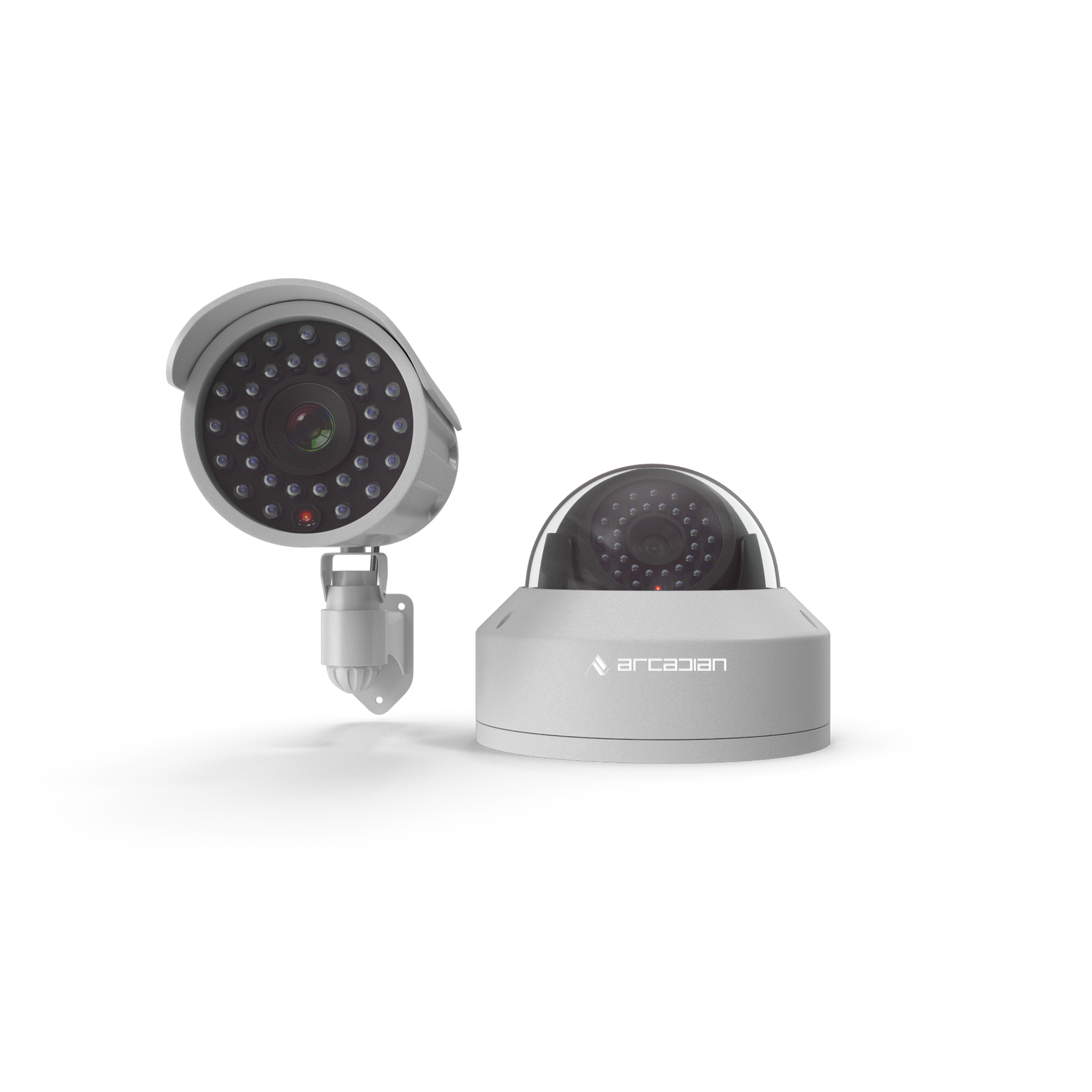Emerging Physical Security Challenges in North America (2025)
Attacks on the grid, insider-enabled armory thefts, and AI-flagged incidents with delayed human response are redefining physical security. Here’s a converged playbook—and why ArcadianAI’s camera-agnostic, cloud platform with Ranger beats static systems.

- Introduction (Why this matters now)
- Quick Summary / Key Takeaways
- Background & Relevance (2024–2025 snapshot)
- Core Topic Exploration
- Comparisons & Use Cases
- Industry Trends & Signals (2025)
- Actionable Recommendations (Your 90-day plan)
- Common Questions (FAQ)
- Conclusion & CTA
- External Sources & Further Reading
- Security Glossary (2025 Edition)
Introduction (Why this matters now)
Physical risk in North America is no longer “just physical.” In 2024 there were ~2,800 reports of gunfire, vandalism, and other strikes on U.S. electrical networks, according to NERC reporting cited by Reuters—only ~3% caused outages, but the operational anxiety is system-wide. (Reuters) Meanwhile, a July 2025 Manhattan high-rise shooting showed that AI video analytics can flag threats—yet human and procedural delays still determine outcomes. (Reuters) Add insider-aided thefts at National Guard armories (night-vision goggles, thermal sights, and more) and you get a cross-domain threatscape where cyber tactics and physical consequences converge. (WIRED)
ArcadianAI’s position: legacy NVR/VMS stacks (e.g., Genetec, Milestone) and camera-locked VSaaS bundles (e.g., Verkada, Eagle Eye, Rhombus) tackle fragments of the problem. You need a converged, cloud-native, camera-agnostic platform that fuses video, access, and cyber telemetry—and automates response. That’s ArcadianAI + Ranger.
Quick Summary / Key Takeaways
-
Grid assaults remain elevated; ~2,800 reports in 2024. (Reuters)
-
Convergence is no longer optional—CISA urges it. (CISA)
-
57% cite outdated physical/IT infrastructure as top challenge (2025). (Security Magazine)
-
AI can detect, but response orchestration decides outcomes. (Reuters)
-
Insider risk is rising—even at military facilities. (WIRED)
Background & Relevance (2024–2025 snapshot)
-
Critical infrastructure pressure: NERC notes ~2,800 physical assault reports on the grid in 2024, keeping post-2022 levels “high.” (Reuters)
-
Active shooter context: The FBI designated 24 active shooter incidents in 2024 (down from 48 in 2023, but still elevated vs. pre-2020 baselines), underscoring the need for faster detection-to-action workflows. (Federal Bureau of Investigation)
-
Modernization gap: 57% of organizations say outdated physical security and/or IT infrastructure is their biggest hurdle (2025). (Security Magazine)
-
Data centers & AI era: Operators are shifting to AI-assisted, multi-layered physical security as facilities scale in size and criticality. (Data Center Knowledge)
Core Topic Exploration
1) Cyber-Physical Threats to Critical Infrastructure
What’s happening: Physical attacks on substations and grid assets (gunfire, sabotage, copper theft) remain elevated; ~2,800 incidents in 2024 were logged by reliability authorities. (Reuters) Copper theft and cable vandalism further weaken resilience in communications and transport systems. (NCTA)
Why it’s hard: OT/ICS networks often sit beside older CCTV/NVR gear with weak segmentation. When physical barriers fail, cyber tooling becomes the last line—and vice versa.
ArcadianAI + Ranger advantage:
-
Perimeter-aware analytics (humans/vehicles, suspicious linger, weapon cues) + behavioral baselines for after-hours anomalies.
-
Zero-trust bridge between video and IT/OT: device inventory, identity-aware access, and tamper/firmware integrity signals surfaced to security ops.
-
Automated playbooks (lock vestibule, trigger strobe/PA, dispatch) integrated with monitoring centers.
-
Camera-agnostic ingestion (Axis, Hanwha, Avigilon, Hikvision*, Uniview*, Bosch, etc.), avoiding lock-in typical of Verkada/Eagle Eye bundles. (*NDAA considerations apply.)
Proof pressure: Utility-adjacent theft and sabotage are up; policy and detection are not enough without coordinated action. (NCTA)
2) The Convergence Imperative (Cyber + Physical)
What it is: CISA defines convergence as formal collaboration (people, process, tech) across cyber and physical functions—a single risk spine. (CISA)
Why now: Interconnected systems (badging, cameras, BMS/HVAC, elevators, parking) mean incidents bleed across domains. Converged tabletop exercises and joint SOPs raise resilience. (CISA)
ArcadianAI + Ranger approach:
-
Unified evidence graph: video + access + endpoint signals on one timeline.
-
Cross-checks: badge event ≠ face/gait match → alert; account login from atypical ASN + door forced open → escalate.
-
Open APIs: integrations with Genetec/Milestone, access control (Lenel, Brivo, Openpath), dispatch/PSIM (Immix, SureView), and incident/case systems.
-
Outcome focus: measured in time-to-contain and time-to-notify, not just “alerts sent.”
3) Technological Modernization vs. Legacy Drag
The gap: 57% cite outdated physical or IT infrastructure as their top challenge; many still run end-of-life NVRs, unmanaged firmware, and siloed VMS analytics. (Security Magazine)
ArcadianAI’s modernization path:
-
Cloud-native AI with edge filtering: send fewer, higher-confidence events to save bandwidth and storage.
-
Hybrid deployments: on-prem bridge + cloud analytics for sovereignty and cost control (vs. all-or-nothing camera-locked clouds).
-
Per-camera profiling: dynamic image tuning, scene-aware thresholds (glare, rain, wildfire smoke), and health checks.
-
Patching & CVE hygiene: policy-driven firmware updates across mixed fleets (Axis, Hanwha, Pelco, Dahua*, Uniview*), with audit trails.
Competitor contrast:
-
Genetec/Milestone: powerful VMS, but modernization often requires capital refresh and complex on-prem care.
-
Verkada/Eagle Eye: simpler cloud UX, but hardware lock-in and less flexibility for mixed estates and sovereignty constraints.
4) AI-Powered Surveillance vs. Human Response Gaps
Reality check: In the NYC 345 Park Avenue case, AI reportedly flagged the gunman just over a minute before police were called, but delays still led to fatalities. AI detection ≠ protection—response orchestration does. (Reuters)
What fixes it:
-
Automation: instantly lock interior doors, trigger voice-down, push floor-plan and camera tiles to responders.
-
Clear authority: pre-authorized actions (e.g., elevator lockout) to avoid legal/operational hesitancy.
-
Training & drills: converged tabletop exercises with facilities + IT + security. (CISA)
ArcadianAI + Ranger:
-
Playbooks that escalate by severity score and confidence.
-
Multi-signal fusion: weapon posture + crowd scatter + badge mismatch → auto-escalate to dispatch.
-
Operator UX: consolidated timeline; one-click evidence export for law enforcement.
5) Insider Threats & High-Value Targets (Armories, Warehouses, Data Centers)
Trend: Multiple armory break-ins in Tennessee show theft crews may exploit insider knowledge (unlocked supply rooms, alarm familiarity) to steal NVGs and thermal sights—exactly the kind of “quiet” vulnerabilities most enterprises share. (WIRED)
Wider lens:
-
Cargo theft rose ~27% in 2024 and is forecast to rise again in 2025; identity-based fraud is surging. (National Insurance Crime Bureau, New York Post)
-
Data centers are hardening with biometrics + AI and converged incident response. (Data Center Knowledge)
ArcadianAI countermeasures:
-
Insider anomaly models (badges outside norms, tailgates behind privileged users, device MAC spoofing).
-
Logistics awareness: LPR + trailer ID + yard geofences + dock door state, linked to video.
-
Data center baselines: mantrap timing, piggyback detection, cabinet door state + badge correlation.
Comparisons & Use Cases
ArcadianAI vs. Common Alternatives (at-a-glance)
| Requirement / Risk | ArcadianAI + Ranger | Genetec / Milestone (VMS) | Verkada / Eagle Eye (VSaaS) |
|---|---|---|---|
| Converged cyber-physical workflows | Native evidence graph + playbooks | Possible via PSIM/integrations | Partial; less cyber context |
| Camera-agnostic modernization | Yes (Axis, Hanwha, Bosch, etc.) | Yes, but often heavier ops | Limited; vendor-locked cams |
| Grid/site perimeter anomaly detection | Behavioral + scene-aware AI | Analytics add-ons vary | Vendor-specific models |
| Insider risk analytics (badge/video/login) | Cross-signal correlation | Requires extra modules | Limited cross-domain fusion |
| Patch/CVE hygiene across mixed fleets | Policy-driven firmware orchestration | Tooling varies by OEM | Primarily vendor hardware |
| Sovereignty/hybrid control | Flexible: cloud + on-prem bridge | On-prem heavy | Cloud-centric |
| TCO/ROI (multi-site, mixed estate) | OPEX with selective edge | CAPEX + integrator costs | OPEX + hardware refresh |
Use Case 1 — Utility Substations (Copper & Vandalism)
-
Problem: Nighttime fence breaches, copper theft, and camera blind spots along access roads.
-
Solution: Ranger sets a no-loiter + vehicle linger baseline, fuses fence vibration sensors, and auto-dispatches when vehicle + fence event + tool posture align.
-
Result: Attempts drop; evidentiary bundles expedite prosecution. (Context: copper/cable theft and vandalism threatening communications infrastructure.) (NCTA)
Use Case 2 — High-Rise & Corporate Campuses
-
Problem: “AI saw it, but we were slow to act.”
-
Solution: Playbooks: weapon cue ⇒ lock vestibule, voice-down, notify SOC + 911 with live tiles; SLA: <30s from detection to call.
-
Result: Cuts the detection-to-action gap highlighted by the Manhattan incident. (Reuters)
Use Case 3 — Distribution Centers & Cargo Yards
-
Problem: Identity-based cargo theft and fraudulent pickups.
-
Solution: Ranger verifies tractor VIN/plates + driver face against dispatch manifest; geo-fenced exit + gate reader mismatch triggers hard stop.
-
Result: Reduced exposure amid 2024’s 27% cargo theft increase. (National Insurance Crime Bureau)
Industry Trends & Signals (2025)
-
Grid & utility vigilance remains priority as physical strikes stay high. (Reuters)
-
Convergence is the operating model (CISA guidance, ISC best practices). (CISA)
-
AI-assisted data center security is standardizing. (Data Center Knowledge)
-
Retail violence & theft continue to reshape LP strategies (NRF/FBI context). (National Retail Federation, Federal Bureau of Investigation)
Actionable Recommendations (Your 90-day plan)
-
Establish a Convergence Council (CISO, CSO, Facilities, OT) with a single risk register and joint SLAs (detection → action). Use CISA’s convergence action guide as a template. (CISA)
-
Map critical assets (substations, mantraps, docks, server rooms) and apply scene-specific AI baselines (ArcadianAI).
-
Instrument response: pre-authorize door locks, elevator holds, voice-down; rehearse tabletop exercises for weapon, tailgating, and insider scenarios. (CISA)
-
Modernize pragmatically: keep existing cameras (Axis, Hanwha, etc.) but layer ArcadianAI for AI + health + firmware governance; retire EoL NVRs over time. (Addresses the 57% legacy hurdle.) (Security Magazine)
-
Secure logistics: LPR + dock door state + load IDs to counter identity-based cargo theft growth. (National Insurance Crime Bureau)
-
Measure what matters: MTTD, MTTA, false alarm rate, % automated actions, % drills meeting SLA.
Common Questions (FAQ)
Q1: Is “security convergence” just buzzword soup?
No. CISA formally recommends converging cyber and physical functions to reduce gaps and speed response. (CISA)
Q2: We already have Genetec/Milestone—why add ArcadianAI?
Keep them. ArcadianAI overlays converged analytics, playbooks, and firmware hygiene across mixed-brand cameras, reducing lock-in and modernization cost.
Q3: Can ArcadianAI prevent another “AI saw it, humans delayed” outcome?
We can’t remove human factors, but automated playbooks and pre-authorized controls shrink detection-to-action time that proved decisive in the NYC case. (Reuters)
Q4: How fast can we modernize without ripping and replacing cameras?
Typical projects start with ArcadianAI bridge + cloud analytics, adding policy-driven firmware, scene baselines, and response playbooks in 90 days.
Q5: Does ArcadianAI support sovereignty/hybrid?
Yes. Run edge + cloud with regional data controls; integrate with SOC tools and PSIM (Immix/SureView) for dispatch.
Conclusion & CTA
Securing the Critical Full Spectrum means accepting a single truth: incidents are cyber-physical by default. Grids face persistent physical attacks; enterprises face insider risk and identity-based theft; AI detects, but orchestrated response saves lives and assets. The winners will converge teams, modernize pragmatically, and automate decisively.
ArcadianAI’s camera-agnostic, cloud-native platform with Ranger unifies detection and response across your mixed estate—without a rip-and-replace tax.
Get a Demo → Get Demo – ArcadianAI
External Sources & Further Reading
-
U.S. grid physical assaults (~2,800 in 2024); NERC via Reuters. (Reuters)
-
Dataminr: grid risks remain high since 2022. (Dataminr)
-
CISA: Cyber-Physical Convergence Action Guide. (CISA)
-
Genetec/2025: 57% say outdated physical/IT infra is #1 challenge; Security Magazine. (Security Magazine)
-
NYC 2025 incident: AI flagged gunman before calls; response lag mattered (Reuters). (Reuters)
-
National Guard armory thefts; insider concerns (WIRED). (WIRED)
-
FBI: 24 active shooter incidents in 2024 (report + press). (Federal Bureau of Investigation)
-
Data center security in the AI era (DataCenterKnowledge). (Data Center Knowledge)
-
Cargo theft up ~27% in 2024; 2025 outlook (NICB; reporting). (National Insurance Crime Bureau)
Security Glossary (2025 Edition)
-
Security Convergence — Formal collaboration of cyber + physical security functions to close gaps and respond faster across domains. (CISA)
-
Cyber-Physical System (CPS) — Interconnected digital and physical components (e.g., OT/ICS, access control, cameras) where compromise in one domain impacts the other. (CISA)
-
Ranger (ArcadianAI) — ArcadianAI’s AI-as-a-Guard engine that fuses video, access, and context into actionable playbooks.
-
VSaaS — Video Surveillance-as-a-Service (e.g., Verkada, Eagle Eye, Rhombus) delivering cloud-hosted camera management and analytics.
-
VMS — Video Management System (e.g., Genetec Security Center, Milestone XProtect) for on-prem video recording/management.
-
Zero Trust — “Never trust, always verify” approach applied to users, devices, and workloads, including cameras and bridges.
-
Tabletop Exercise (CTEP) — Guided simulation (often from CISA) to test incident response across converged cyber-physical teams. (CISA)
-
Identity-Based Cargo Theft — Fraud where criminals impersonate carriers/brokers to pick up loads; a fast-growing U.S. tactic. (National Insurance Crime Bureau)
-
Piggybacking/Tailgating — Unauthorized entry following an authorized user through a secured door; mitigated by mantraps/AI.
-
Firmware Hygiene — Policy-driven updates, integrity checks, and audits across mixed camera fleets to reduce vulnerabilities.
-
Severity Scoring — Weighted risk score combining model confidence + context (e.g., weapon posture + crowd reaction) to drive automated playbooks.
-
MTTD/MTTA — Mean Time to Detect/Alert; key metrics for measuring converged security performance.
-
Sovereignty Controls — Regional data residency, access, and processing choices for compliance in hybrid/cloud deployments.
-
Per-Camera Profiling — Scene-aware calibration (lighting, weather, occlusion) for robust analytics and lower false alarms.

Security is like insurance—until you need it, you don’t think about it.
But when something goes wrong? Break-ins, theft, liability claims—suddenly, it’s all you think about.
ArcadianAI upgrades your security to the AI era—no new hardware, no sky-high costs, just smart protection that works.
→ Stop security incidents before they happen
→ Cut security costs without cutting corners
→ Run your business without the worry
Because the best security isn’t reactive—it’s proactive.







